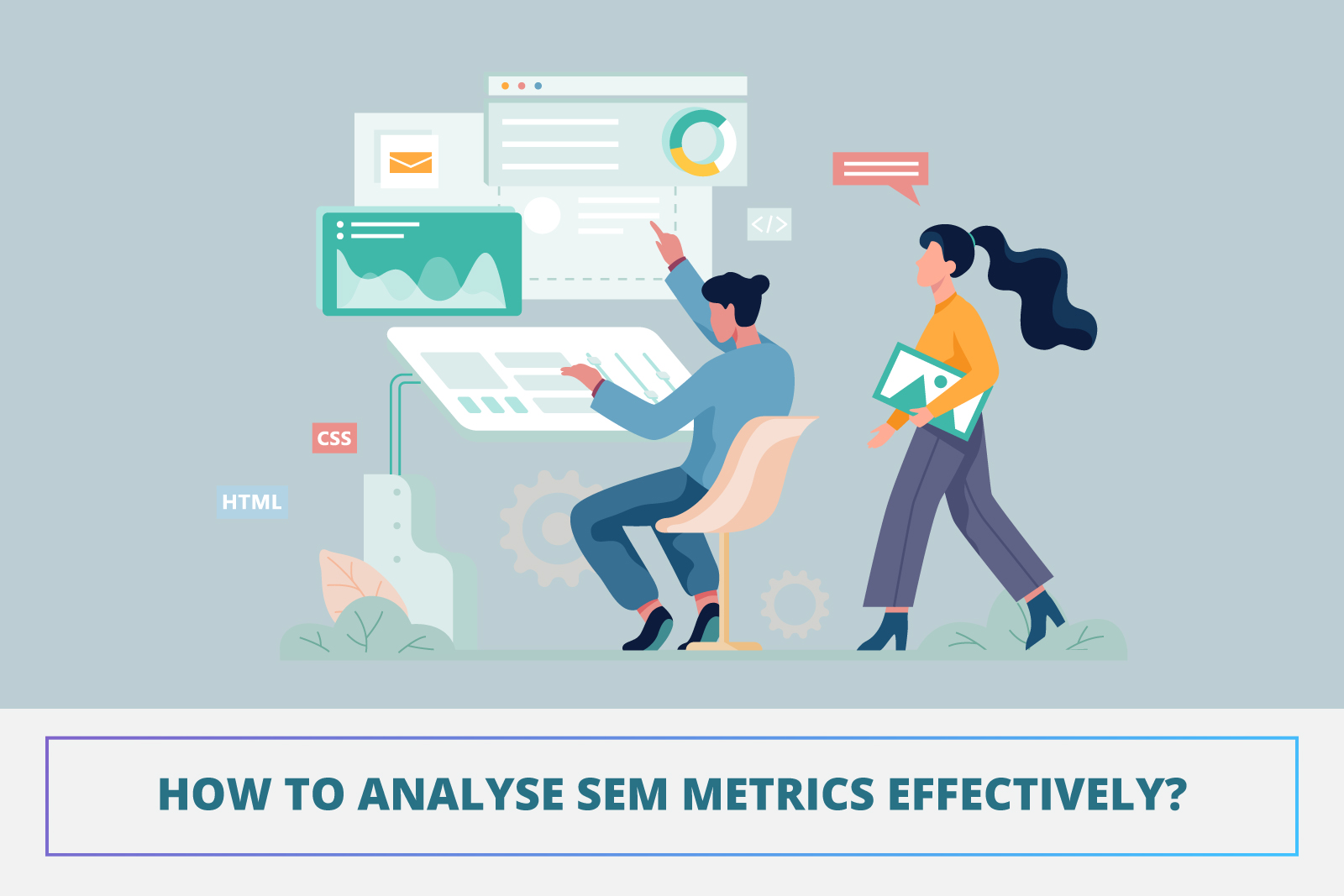SEM (Search Engine Marketing):
SEM is a marketing analytics platform where you can improve your business. Search engine marketing is a platform where you do your brand advertisement. Your brand or product advertisement increases as you invest more. If you need a higher rank for your brand to remain on top, you should bid more or use good content and keywords for ads. In SEM, you pay google to show ads of your brand or product on search engines.

If anyone searches a keyword matching your product, this determines what standards your brand or product has. For example, if a customer or a user search for a product and use excellent keywords by investing money in the products, your ad will appear on the first page of search engines. If more people click and visit your product, then your business and revenue will be grown up. In SEM, we do a paid advertisement. Customers do not try to find more results. They click on the first shown ad and visit this. A business should do such work on its brand advertisement that its product ad should be on the first page of the search engine.
Search Engine Marketing application?
Following are the reasons to use SEM metrics:
- To approach the customer.
- To judge brands ratings.
- To enhance business and revenue.
- To check where you stand in the market.
The requirements are for judging the SEM applications. There are many ways to analyse search engine marketing metrics. Following are the methods that explain how we analyse SEM metrics effectively. Different types of metrics can be analysed while doing brand or product advertisements.
SEM Ad impression:
To improve your product rating, you should analyse the ad impression matrix. Impression and clicks are two different terminologies in advertising. Impression means that a customer search matches your keyword, but the customer does not click on your advertising ad. Sometimes, if a customer searches for a product, your brand ad appears in suggestion and, customers see it but do not click on this. There is no need to become a pleasure if your impression increase. It is only the policy of Google. Sometimes, some products have less impression but, no of clicks are high and, it’s a success of your brand. Calculate an impression to click ratio and improve your product advertisement.

SEM Ad clicks:
When a customer searches for a product on the google search engine, then google rank your advertisement ad on first, second and, so on, then the customer clicks on your ad and see the standard and review of your brand or product. Then it is counted as several clicks. Several clicks decide your ad standard and your business progress. Click-through-rate (CTR) can be calculated by counting no of impressions and clicks. Google shows no clicks in percentage. No of the clicks areas.
For example, if no of impressions is 1800 and no of clicks are 200, the CTR is;
CTR = 11.11%
If you want to improve your Click-Through ratio, improve your keywords, set up your graphic design. Also, notice what are the negative points and positive points in your keywords. Always use positive keywords and remove negative keywords. Use such keywords that almost match the customer search. Always Fresh your website.
Selecting keywords:
In SEM, the keyword matrix plays a role to enhance your business. The strength of keywords is a part of your brand rating. If you use strong, short, and valid keywords, your ad will be the most searched in the search engine. Keywords determine the no of clicks and impressions. Your bid with google and keywords decide the rank of your brand ad and website on the first no or first page of the search engine. So, analyse your strength of keywords. Take a look at the keywords that change daily. Judge positive and negative words. Search the keywords of most traffic products. Remove the negative words and add the positive words to your blog.
Cost per click:
Cost per click is a payment of click when a customer clicks on an ad. The marketers or the businessmen pay the cost. CPC depends upon cost through rate. If CTR increases, then CPC decreases. So, your focus should be on CTR. If a marketer or a businessman bid for a brand advertisement with google, he paid according to cost per click. If you choose the keywords and more users visit your brand ad, your CPC can be decreased. If CPC decreases, your budget will reduce for advertising. It’s a plus point for your business. The cost-per-click can be calculated as.
For example, if you have a cost of $250 for your brand advertisement and 500 total number of clicks then the cost per click is $0.5. From the above formula, you can analyse your budget for an advertisement. If you stand in a competitive market, you can analyse the cost-per-clicks value of another marketer. Compare these results and determine your CPC.
Ads sharing:
Ads sharing also determine your progress of business and advertisement of your brands. If you use strong keywords then, most users visit your brand. If your brand has a high rating and low rate that satisfy users, the user will be impressed. The user wants to share your product. If you pay for sharing and invest more for this purpose then, traffic increase on your website. You can get more clicks and more selling of your product. Ad’s sharing is a chain reaction, and, in this way, advertisements vary from person to person. In a short time, your brand will be visited by millions of people. So, in this way, you can analyse your brand by using search engine marketing.
Users stay time on brand website:
Above all explaining, metrics decide the business progress based on counting. These metrics show the stay time of users on the website. When a user clicks on the ad, then how much time he stays on site. It shows the interest of the customer. By analysing this metric, a marketer sees the behaviour of customers to his brand. If the keywords are interesting, the user stays on site. Site stay time decides the rating of your brand. If a consumer is interested in your content, he can be visiting more pages on your website. Due to this, the stay time of the user increases. Another way to increase the interest of users on the website is; to pay for the stay time of the user on a website. Google increase the time of your ad on the user screen. If we visit a website or see a video, many ads come on our screen and can be skipped in 5 seconds or more. In this way, users stay on the ads for a while.
Cost per Acquisition (CPA):
After analysing all the above steps, the next step is to analyse, how many users are your client. This metric determines that if a user clicks on your advertisement and remains on-site for a time, he will log in to your website by his mail. He will give some positive comments, giving 4 or 5 stars to your product. He can like or dislike your brand. It all determines your advertisement campaign. How could your campaign be done effectively? You can analyse cost per acquisition by calculating it. CPA calculation is.
This cost decides your marketing budget per client. How much money, you spend on advertisement per client?
Expert and teamwork:
If you have an expert team to deal with search engine marketing, your product can advertise correctly. You can analyse your brand progress on a daily. Many experts can be found. You pay them and, they will advertise your product or brand. Also, they analyse your brand progress as compared to other companies. They guide you in your brand keywords. They analyse the positive and negative aspects of your brand. They intact with the client by emails or phone numbers. They send them advertisements personally in user mails that you collect from your website when a client login to your page. So, in this way, you can analyse your brand very well.
Product purchase by client:
After the metrics analysis, the last and desired requirement of the whole advertising campaign is how many clients visit the site, share the website, stay on-site, pass comments, give a rating, login by mail and purchase your brand. It is the final desire of a marketer. Many visitors fulfil all market requirements and, the number of users who visit a website is analysed by it. For example, if no. of visitors is 100 and visitors who perform all requirements are 20, it is called a purchasing ratio. And it can be calculated as, no of visitors that fulfil all requirements divided by total no of visitor multiply by 100. After calculating the above example, it could be 20%. It means that if 100 users visit sites, then 20 visitors can purchase the brand. I hope you will understand all analysed metrics. Best of luck!







